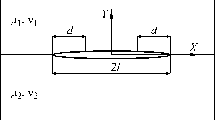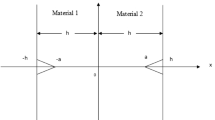The parameters of a small-scale failure zone in the bonding material of a piecewise-homogeneous body under plane strain condition are determined using the Wiener–Hopf method. The failure zone is located at the end of an interface crack with tip at the corner point of the polygonal interface of the materials. The crack faces contact according to the law of dry friction. The failure zone is modeled by discontinuity line of the normal displacement on which the normal stress is equal to the tensile strength of the bonding material. Expressions for the length of the failure zone, the opening displacement of the crack faces, and local stress field near the crack tip are derived. The starting mechanism of the initial crack is described. It is assumed that a microcrack nucleates in some part of the failure zone and coalesces with the initial crack with increasing load. The dependence of the parameters of the failure zone, the microcracks, and the limiting load on the load and the parameters of the composite are analyzed numerically.
Similar content being viewed by others
References
V. M. Nazarenko and O. L. Kipnis, “The limiting equilibrium of a piecewise-homogeneous elastic body with interface shear cracks at the corner point of the interface of media,” Dop. NAN Ukrainy, No. 3, 36–42 (2018).
N. Aravas and S. M. Sharma, “An elastoplastic analysis of the interface crack with contact zones,” J. Mech. Phys. Solids, 39, No. 3, 311–344 (1991).
B. Audoly, “Asymptotic study of the interfacial crack with friction,” J. Mech. Phys. Solids, 48, No. 9, 1851–1864 (2000).
V. L. Bogdanov and A. L. Kipnis, “Investigation of the fracture of a semibounded body compressed along a near-surface interface crack,” J. Math. Sci., 253, No. 1, 99–107 (2021).
M. Comninou, “The interface crack,” J. Appl. Mech., ASME, 44, 631–636 (1977).
M. Comninou and J. Dundurs, “Effect of friction on the interface crack loaded in shear,” J. Elasticity, 10, No. 2, 203–212 (1980).
M. V. Dudyk and Yu. V. Dikhtyarenko, “Development of a prefracture zone from an interfacial crack at a corner point of an interface of two elastic media,” J. Math. Sci., 184, No. 2, 121–135 (2012).
M. V. Dudyk and Yu. V. Dikhtyarenko, “Investigation of the influence of plasticity of materials on the strength of a composite joint,” J. Math. Sci., 201, No. 1, 83–98 (2014).
M. V. Dudyk and Yu. V. Dikhtyarenko, “Investigation of the initial stage of kinking of an interface crack at an angular point of the interface of two media,” Mater. Sci., 47, No. 5, 627–635 (2012).
M. V. Dudyk and L. A. Kipnis, “Model of the structure of the near-tip area of interface crack in a piece-homogeneous elastic-plastic body,” Strength, Fracture and Complexity, 11, No. 1, 31–50 (2018).
J. Dundurs and A. K. Gautesen, “An opportunistic analysis of the interface crack,” Int. J. Fract., 36, 151–159 (1988).
A. H. England, “A crack between dissimilar media,” J. Appl. Mech., ASME, 32, No. 2, 400–402 (1965).
F. Erdogan, “Stress distribution in bonded dissimilar materials with cracks,” J. Appl. Mech., ASME, 32, No. 2, 403–410 (1965).
F. D. Gakhov, Boundary Value Problems, Pergamon Press, Oxword (1966).
A. N. Guz, L. V. Bogdanov, and V. M. Nazarenko, Fracture of Materials under Compression Along Cracks, Ser. Advanced Structured Materials, 138, Springer Nature Switzerland AG, Cham (2020).
A. N. Guz, “Establishing the foundations of the mechanics of fracture of materials compressed along cracks (Review),” Int. Appl. Mech., 50, No. 1, 1–57 (2014).
A. N. Guz, “On physically incorrect results in fracture mechanics,” Int. Appl. Mech., 45, No. 10, 1041–1051 (2009).
K. P. Herrmann and V. V. Loboda, “On interface crack models with contact zone situated in an anisotropic bimaterials,” Arch. Appl. Mech., 69, 317–335 (1999).
A. O. Kamins’ky, M. V. Dudyk, and L. A. Kipnis, “Investigation of the process zone near the tip of an interface crack in the elastic body in shear within the framework of the complex model,” J. Math. Sci., 220, No. 2, 117–132 (2017).
A. A. Kaminsky, L. A. Kipnis, and V. A. Kolmakova, “On the Dugdail model for a crack at the interface of different media,” Int. Appl. Mech., 35, No. 1, 58–63 (1999).
A. A. Kaminsky, “Studies of subcritical crack growth in viscoelastic anisotropic bodies using the continued fraction operator method: synthesis and summary,” Int. Appl. Mech., 57, No. 3, 266–283 (2021).
A. A. Kaminsky, M. V. Dudik, and L. A. Kipnis, “On the direction of development of a thin fracture process zone at the tip of an interfacial crack between dissimilar media,” Int. Appl. Mech., 42, No. 2, 136–144 (2006).
A. A. Kaminsky, M. V. Dudyk, V. M. Fenkiv, and Y. O. Chornoivan, “On the scope and limitations of the Comninou model for the crack on the polygonal interface,” Int. Appl. Mech., 58, No. 4, 398–409 (2022).
A. A. Kaminsky and E. E. Kurchakov, “Fracture process zone at the tip of a mode 1 crack in a nonlinear elastic orthotropic material,” Int. Appl. Mech., 55, No. 1, 23–40 (2019).
A. A. Kaminsky and E. E. Kurchakov, “Mechanism of development of the area of passive deformation in a nonlinear elastic orthotropic body with a crack,” Int. Appl. Mech., 56, No. 4, 402–414 (2020).
V. M. Nazarenko and A. L. Kipnis, “Influence of interface shear cracks located near the angular point of the interface in a bi-homogeneous body on the stress state formed in the vicinity of this point,” J. Math. Sci., 261, No. 1, 151–161 (2022).
A. Needleman, “An analysis of decohesion along an imperfect interface,” Int. J. Fract., 42, No.1, 21–41 (1990).
B. Noble, Methods based on the Wiener–Hopf Technique for the Solution of Partial Differential Equations, 2nd ed., Chelsea Pub. Co., New York (1988).
J. R. Rice and G. C. Sih, “Plane problems of cracks in dissimilar media,” J. Appl. Mech., ASME, 32, No. 2, 418–423 (1965).
C. F. Shih and R. J. Asaro, “Elastic-plastic analysis of cracks on bimaterial interfaces. Part 1: Small-scale yielding,” J. Appl. Mech., 55, 299–316 (1988).
C. F. Shih and R. J. Asaro, “Elastic-plastic analysis of cracks on bimaterial interfaces. Part 11: Structure of small-scale yielding fields,” J. Appl. Mech., 56, 763–779 (1989).
P. S. Theocaris and E. E. Gdoutos, “Stress singularties in cracked composite full-planes,” Int. J. Fract., 13, No. 6, 763–773 (1977).
V. Tvergaard, “Predictions of mixed mode interfacial crack growth using a cohesive zone model for ductile fracture,” J. Mech. Phys. Solids, 52, 925–940 (2004).
M. L. Williams, “The stresses around a fault or crack in dissimilar media,” Bulletin of the Seismological Soc. of America, 49, 199–204 (1959).
Author information
Authors and Affiliations
Corresponding author
Additional information
Translated from Prykladna Mekhanika, Vol. 58, No. 5, pp. 39–51, September–October 2022.
This study was sponsored by the budgetary program Support of Priority Areas of Research (KPKVK 6541230).
Rights and permissions
Springer Nature or its licensor (e.g. a society or other partner) holds exclusive rights to this article under a publishing agreement with the author(s) or other rightsholder(s); author self-archiving of the accepted manuscript version of this article is solely governed by the terms of such publishing agreement and applicable law.
About this article
Cite this article
Kaminsky, A.O., Dudyk, M.V. & Fen’kiv, V.M. Starting of an Interfacial Crack with Contacting Faces from the Corner Point of a Polygonal Interface. Int Appl Mech 58, 533–544 (2022). https://doi.org/10.1007/s10778-023-01178-1
Received:
Published:
Issue Date:
DOI: https://doi.org/10.1007/s10778-023-01178-1




